Hibiscus plants can bring a touch of tropics to your interior and exterior space. But are you upset about their sticky leaves? I understand. So, let’s understand why this might be happening.
Pests like aphids, mealybugs, whiteflies, and spider mites suck the plant sap and release honeydew, making the leaves of your hibiscus plant sticky. To fix the sticky leaves, get rid of the pests as soon as possible. Spraying Neem oil once a month can prevent severe infestations.
Other reasons could be nectar secretion and bacterial infections. This guide will give you detailed knowledge about the reasons behind sticky leaves and simple ways to resolve and prevent them.
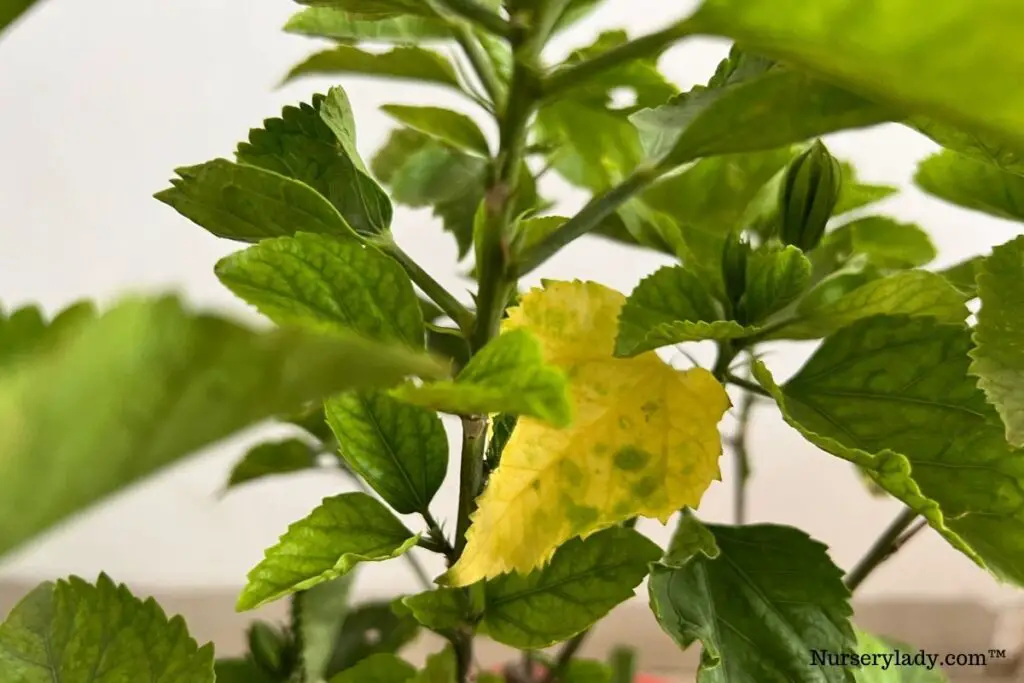
Why are the leaves of my Hibiscus plant sticky?
The primary cause behind Hibiscus leaves becoming sticky is pest infestation.
Aphids, mealybugs, etc., secrete a sticky substance called honeydew.
Later on, this stickiness invites ants, other insects, and a black fungus called sooty mold.
Other than pest infestation, sticky leaves could be due to nectar production.
Hibiscus flowers are full of nectar and pollen, which attracts insects.
Due to the secretion of nectar, the leaves could be a bit sticky.
There are a few more reasons.
Let’s learn about all of them in detail.
Sticky leaves due to pest infestation
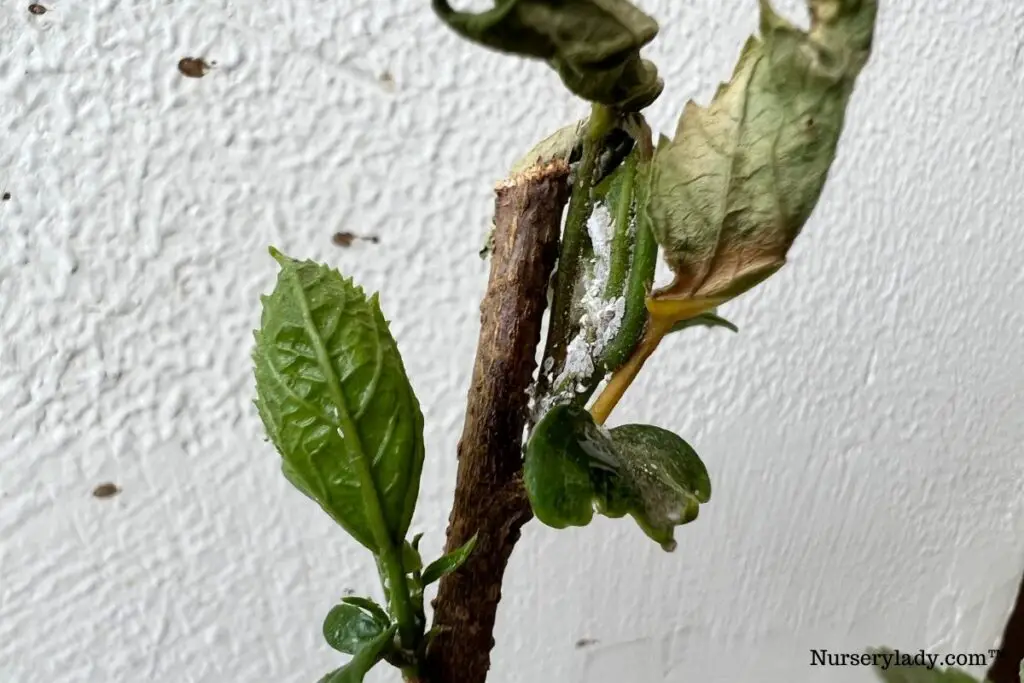
Hibiscus plants are hard to kill unless you stress them with some unfavorable conditions.
A sick plant easily gets prone to bug infestation.
Out of several bugs, aphids, spider mites, mealybugs, and whiteflies are the bugs that produce honeydew on the leaves after sucking the sap of the plant.
This honeydew is their poop which they release on the plant leaves after digesting all the sugars present in the sap.
When you are unaware of their infestation, the bugs continue producing the honeydew on the leaves.
When you touch the leaves one day, you will find them sticky, thus giving you a feeling of irritation and disgust.
Suppose the bugs continue to produce this honeydew.
In that case, the substance will drop to the other unaffected leaves on the lower parts.
Over time, it can attract ants, other insects, and a sooty mold.
The condition snatches their vigor and color and makes Hibiscus plants dull and unattractive due to the ants and fungal disease.
If not taken action beforehand, your plant will quickly become prone to various fungal diseases.
It won’t be easy to revive the plant.
Also read: How Do I Get Rid Of Bugs On My Hibiscus? (Common Bugs+Fix)
Sticky leaves due to nectar secretion
Every flowering plant will produce nectar to attract pests or ward them off.
Hibiscus plants are no exception.
Nectar secretion to ward off insects
Hibiscus plants have secretory structures known as extrafloral nectaries.
These glands are located on every non-flowering part of the plant.
These structures produce a sticky fluid or nectars, which trap the insects and protect the plant from bugs and insects.
Here forms a symbiotic relationship where this stickiness is essential for the plant’s survival.
When the insects reach close to invading the Hibiscus plant, it turns on its defense mode and starts secreting this nectar.
This sticky fluid is unattractive to insects.
Sometimes trichomes produce a sticky fluid like this.
The fluid makes the insect difficult to infiltrate the leaf surface.
Sometimes, this sticky fluid contains some toxins which can kill the insect.
Due to the nectar secretion or sticky fluids, the leaves will become sticky.
Nectar secretion to attract insects
The plant has another structure called floral nectaries at the flowering parts.
Nectar secretes through these parts to attract insects like bees and butterflies for pollination and reproduction.
It is done so that the insects can take the plant species from one plant and transfer it to another through pollination.
This process is called entomophily.
Due to the secretion of these nectars, the leaves may sometimes feel sticky.
If your plant does not have any pest infestation, the stickiness may be due to this nectar secretion.
Looking for gardening supplies? We have tested 100's of products before recommending them to you guys. Check out our best pick below:
| Image | Gardening Supplies | Best Price? |
|---|---|---|
 Top
Top Top
Top | Raised Garden Bed Kit | Check On Amazon |
 | XLUX Soil Moisture Meter, Plant Water Monitor, Soil Hygrometer Sensor for Gardening, Farming, Indoor and Outdoor Plants, No Batteries Required | No Results |
 Top
Top Top
Top | 82 Pcs Garden Tools Set and Extra Succulent Tools Set | Check On Amazon |
 | Joeys Garden Expandable Garden Hose with 8 Function Hose Nozzle, Lightweight Anti-Kink Flexible Garden Hoses, Extra Strength Fabric with Double Latex Core, (50 FT, Black) | No Results |
 Top
Top Top
Top | Dual Chamber Compost Tumbler | Check On Amazon |
 Top
Top Top
Top | Sunnyglade Plant Stakes | Check On Amazon |
 Top
Top Top
Top | Organic Cold Pressed Neem Seed Oil | Check On Amazon |
 Top
Top Top
Top | Mighty Mint Gallon :-Insect and Pest Control Peppermint Oil | Check On Amazon |
 Top
Top Top
Top | Scotts DiseaseEx Lawn Fungicide | Check On Amazon |
 Top
Top Top
Top | Jacks Classic 20-20-20 All Purpose Fertilizer | Check On Amazon |
 Top
Top Top
Top | 30,000 Seeds Pollinator Attracting Wildflower Mixture | Check On Amazon |
 Top
Top Top
Top | Survival Vegetable Seeds Garden Kit-Over 16,000 Seeds | Check On Amazon |
Sticky leaves due to bacterial infections
Sometimes, sticky leaves can be the result of some bacterial infections.
It is often caused when Hibiscus faces unnecessary cuts and wounds while transplanting or pruning.
These wounds remain exposed to the open air and become a path for bacteria and fungi to enter the plant.
A bacterial infection that can cause sticky and limp leaves is Erwinia infection.
Generally, this bacteria is present in the soil but increases due to excessive warmth, fertilizer, and heavy growing medium.
Erwinia bacteria are sometimes considered an agent of Soft Bacterial Rot.
They generally are found in the cyclamen tubers.
How do I stop the leaves from being sticky?
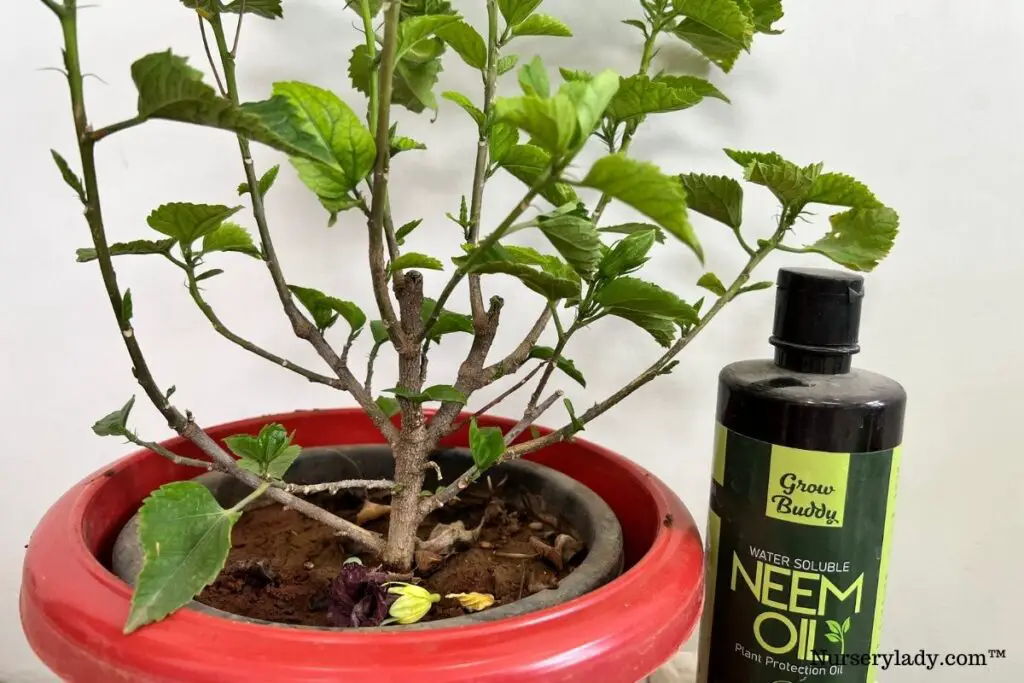
It would be best to control the issues to stop the leaves from getting more sticky and prevent further re-occurrence.
The problem is mainly pest infestation and bacterial infection.
You need to fix the problem and take preventive steps to stop it from occurring again.
As for the nectar secretion, it is a natural process.
In that case, you should clean the leaves to prevent invaders.
How do I remove aphids?
Aphids are tiny sap-sucking insects that suck the saps from the xylem and phloem of the leaves.
They leave behind these saps through their poop after digestion in the form of honeydew.
They are generally found under the leaves.
So, when you suspect aphid infestation, check the underside of the leaves.
That is the place of their living.
Aphids enjoy moist conditions.
You can identify the infestation if you find:
- Transparent green bugs on the stems and under the leaves
- The leaves will turn yellow and curly.
- Due to honeydew’s presence, there will be black fungal growth and sooty mold.
- The flower buds will not open.
To get rid of the aphids from the Hibiscus plant:
- If the infestation is caught early, a forceful and thorough shower will dislocate the bugs from the stems and leaves.
- Imidacloprid can kill them systemically. Apply the chemical to the ground and let the soil and the plant absorb it. When the aphids suck the saps, they absorb the chemical and get killed. It will also kill the other soil insects and termites.
- Spray a soap solution. Add a handful of detergent with one bucket of water and mix it well. Transfer the mixture to a spray bottle and apply it to the Hibiscus leaves and stems. Coating the bugs with the mixture will cut off their oxygen. Once the bugs are dead, wash the corpses off with clean water. The soapy water can also clean the sticky leaves.
- Use neem oil solution to the infected areas. Repeat the treatment 1-2 times per week to eliminate all the bugs.
- Release natural predators like ladybugs, mantis, and lacewings. Keeping some mint and dill weeds can attract these predators naturally.
How do I get rid of spider mites?
Spider mites are another type of sap-suckers.
They lay eggs and spin webs like normal spiders.
When they feed on the sap, they pierce the leaves, especially the young ones.
Once they are done feeding, the underside of the leaves will have a sticky feeling due to honeydew.
To get rid of the spider mites, you can follow a lot of methods:
- Dilute one teaspoon of horticultural oil with 1/4th part water and spray it on the plant.
- Soak a cloth with Vicks and wrap the affected leaves.
- Remove the infected areas from the plant.
- Shower the plant thoroughly and forcefully to blast off their communities and eggs.
- Add 2½ tablespoons of liquid dish wash soap or hand wash soap with water. First, apply it to a small portion of your plant. If it doesn’t show any negative reaction within 24 hours, use it on the infected parts. It will also help to remove the stickiness from the leaves. Spray them on the stems and both sides of the leaves.
- Spray the soapy water for 4-7 days until the problem got resolved.
- Spray neem oil on the infected area.
How do I eliminate mealybugs?
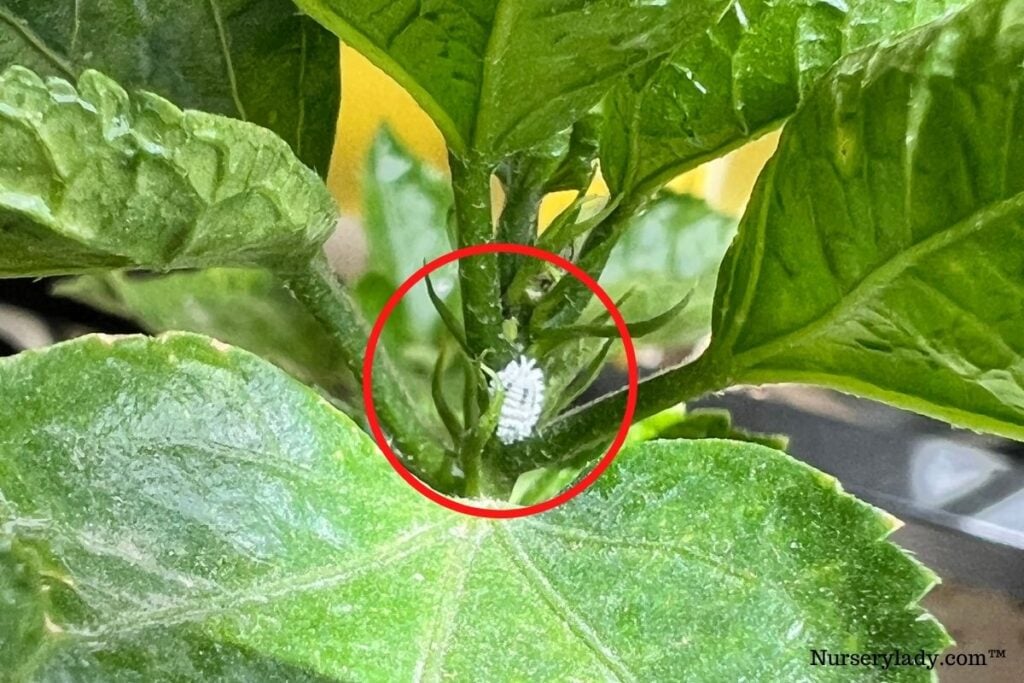
Mealybugs are small white bugs with a waxy coating protecting them from pesticides.
When they attack your plant, you will find some white cottony substance under the leaves.
You will also find the leaves sticky due to their secretion of honeydew.
To remove spider mites from the Hibiscus plant:
- Dab a solution of Isopropyl or rubbing alcohol on the infected areas. It will weaken their shield and also kill them.
- Use neem oil. Add half a teaspoon of neem oil with one teaspoon of mild liquid soap, and add the mixture with one liter of lukewarm water. Spray this mixture directly on the bugs. Do it every few days regularly until the problem persists.
- Insecticidal soap can help. Add two tablespoons of the soap with one-gallon water and spray on the plant. The soapy water can help to eradicate the stickiness too.
- Add one handful of wood ash with 2 cups of water and spray directly on the bugs. You can also apply wood ash in powder form.
- Essential oils like citrus, peppermint, or thyme will also eliminate bugs. Add ½ teaspoon of the oil, 1 tablespoon of mild liquid soap, and 1 liter of lukewarm water. Shake well and spray the solution straight on the bugs.
- Sprinkle some diatomaceous earth in the affected areas. It keeps other bugs and insects away from the plant.
How do I extricate whiteflies?
Whiteflies are not real flies.
They have four wings and are bugs like the others above.
Their mouth organs support the sucking of the saps from the leaves and making them limp and weak.
They also release honeydew like the other bugs, for which the leaves will have a sticky feeling.
If not acted beforehand, the leaves will develop a sooty mold.
To remove whiteflies:
- Since they have wings, use yellow sticky cards to trap them.
- Remove the damaged leaves from the plant.
- Clean the leaves to remove the stickiness.
- Shower the plant thoroughly to dislodge them and make them fly away.
- Use soapy water. It will remove the bugs and also eliminate the stickiness. Add 1 tablespoon of liquid dish wash soap with one-gallon water and apply it to the stems and under the leaves. Use it every couple of days to remove the adults and their eggs.
How do I fix the bacterial infection?
Many people mistake bacterial infection for some other kind of fungal disease and treat the problem incorrectly.
You can remove the damaged parts from the plant, but it will expose cut parts to the open air again.
So, you can use cinnamon on the wounded and infected parts of the plant.
Other methods to control the infection are as follows:
- Let Hibiscus have plenty of sunlight to eliminate the infection from the plant.
- Avoid using over-acidic soil. The soil pH should be between 6.5 and 6.8.
- Avoid overwatering or underwatering the plant frequently.
- Don’t use an excessive amount of nitrogen. Hibiscus needs average nitrogen, low phosphorus, and high potassium.
- Always sanitize the gardening tools before and after use to eliminate the fungus and bacteria. It will kill them and prevent spreading.
- While maintaining high humidity, ensure proper air circulation. Protect the plant from extreme temperatures, be it hot or cold.
- Never re-use the infected containers or soil. Always discard them.
- If you insist on using the old pot, soak it in bleach and water (1:9) for some hours, scrub and wash it with soap water, and keep it under the sun to dry it up. Don’t expose the containers to the sun for a long time. That can crack the planter.
Why and how should I clean the sticky leaves?
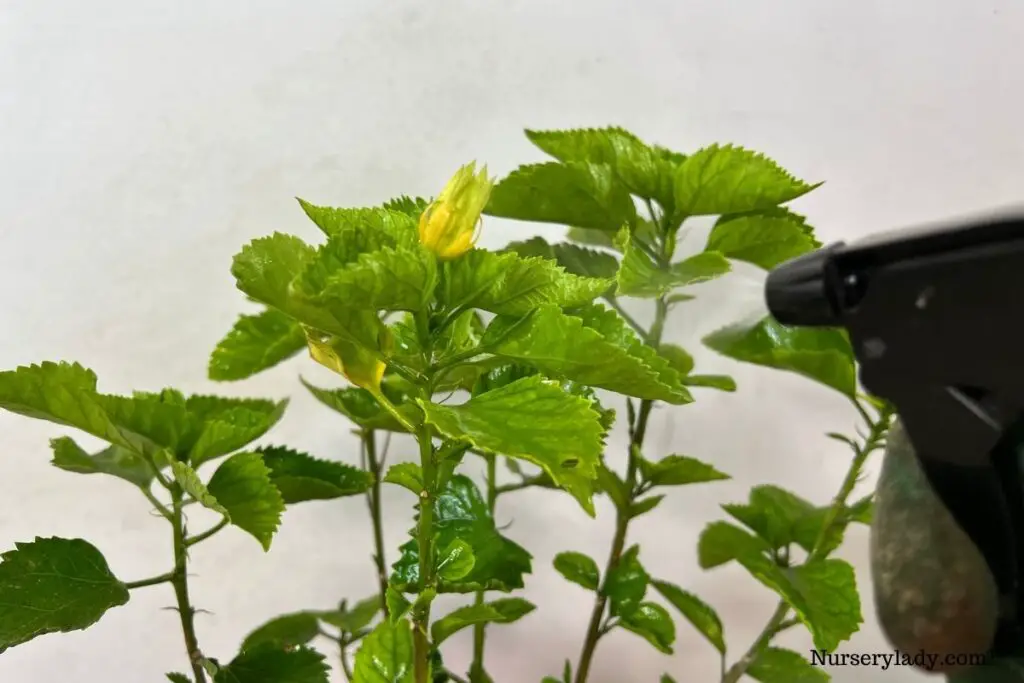
When the leaves have the nectar or honeydew on the leaves at a huge amount, they will begin to drop off the leaves and transfer to other lower leaves.
In this way, most of the leaves will become sticky.
If this happens, many insects will get attracted to your plant.
The stickiness will result in sooty mold largely on the leaf surface.
It will block the photosynthesis of the plant.
The sticky substances (nectar or honeydew) will cause dust and catch other pathogens.
It will cause the build-up of many pathogens, thus making the plant very unattractive and prone to diseases.
Due to these reasons, you must clean the sticky leaves as soon as possible.
Otherwise, reviving the plant would become difficult.
Now, how would you clean the leaves? Here’s how:
- Add one teaspoon of DAWN dish wash detergent with 1/4th warm water. You can use any other detergent if you don’t have this particular one. Dip a cotton ball into the mixture and wipe the leaves with it.
- If you don’t have any detergent, you can clean the leaves with rubbing alcohol. Soak a cotton ball in the alcohol and wipe the leaves. The alcohol and the detergent will break down the sugars accumulated from the nectar and honeydew. The leaf surface will become clean, and the plant can photosynthesize again like before.
Final thoughts
Sticky leaves can make your plant messy, unattractive, and stressed out. That is why you need to get rid of the pests and bacterial infections.
Misting the leaves frequently and showering the plant weekly will clean the plant and remove the stickiness caused due to nectar secretion and honeydew.
Take quick action to control pest infestation when you spot any such troubles in your plant. Nectar secretion is natural. So, observe your plant to confirm the reason behind stickiness.
If you haven’t misted or showered your plant and the leaves are very sticky, take extra effort and clean them with soapy water or rubbing alcohol.
Reference: Wikipedia, ASPCA, Louisiana State University Agricultural Center, American Society for Horticultural Science, Tropical Hibiscus by Texas A&M University, Sciencedirect.
